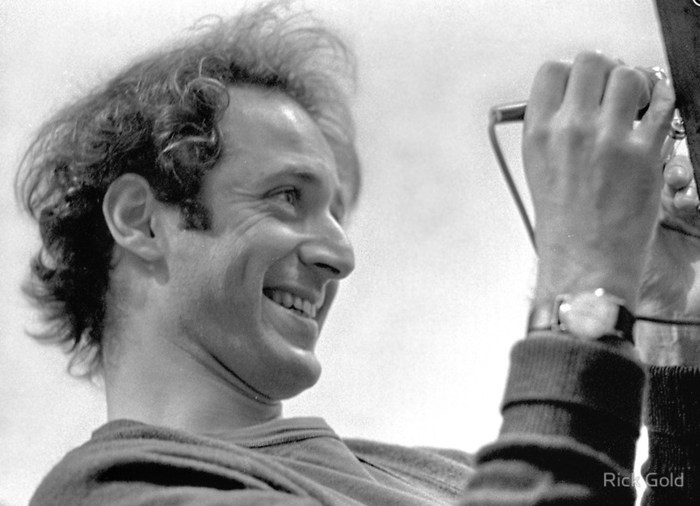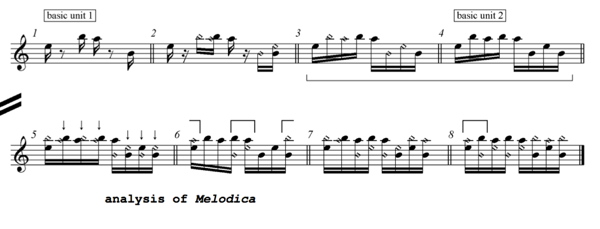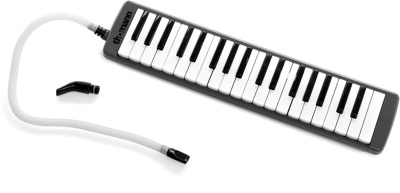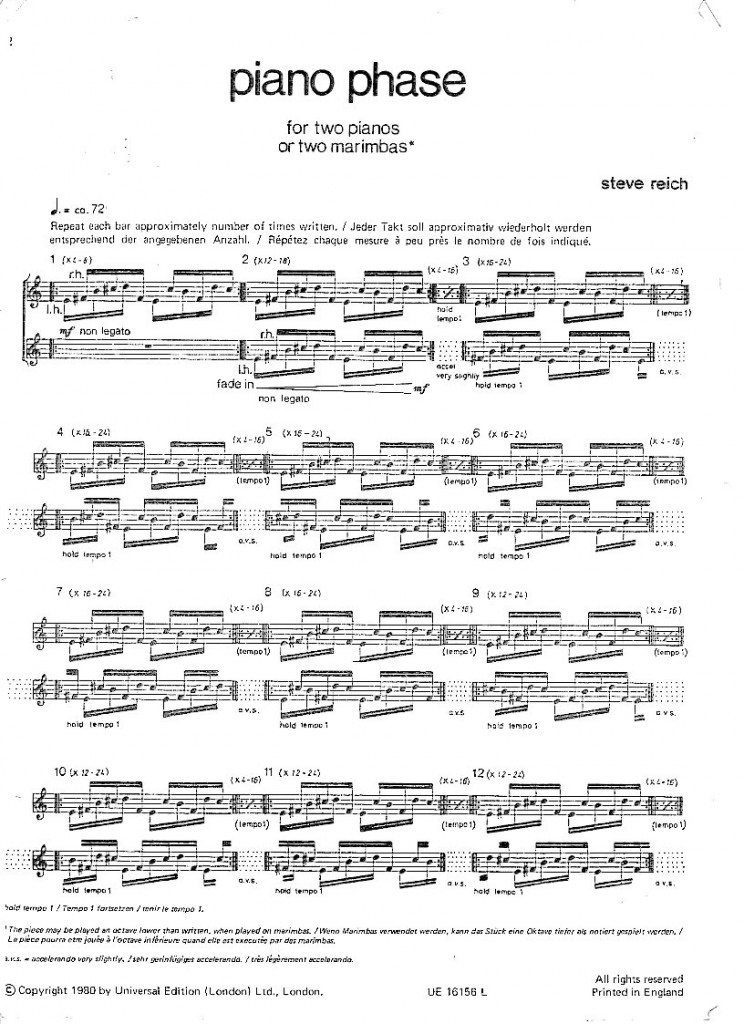Research Studies/Études & Recherche : — [Studies - Multiple Instrument Works / Œuvres à Instruments Multiples ou Égaux] —
MELODICA, REED PHASE, PIANO PHASE, VIOLIN PHASE (STEVE REICH)cinquième partie / Part 5 |
Description(Edit)
Reich entrevoit cependant assez rapidement les limites de la technique de déphasage et commence dès Violin Phase (1967) à ne plus se focaliser exclusivement sur le résultat brut du processus. Le compositeur intègre alors des « motifs résultants » qui consistent en la superposition des différentes voix créant, de manière spécifique et différente pour chaque auditeur, des illusions psycho-acoustiques de perception de sons supplémentaires. Il décide aussi explicitement du nombre de temps de déphasage et de l'ajout de voix supplémentaires. L'introduction de choix esthétiques de la part du compositeur éloigne ces pièces d'un pur statut de pièces expérimentales, n'étant plus le simple résultat d'un processus de déphasage,. Toutefois, Reich voit ses œuvres de la période 1965-1971 comme étant des pièces radicales, des études rigoureuses d'une technique, qu'il étudiait obstinément. | À la suite de It’s Gonna Rain et Come Out, et après une série de pièces de transition (Melodica, Buy Art Buy Art, My Name Is), Steve Reich considère qu’il atteint les limites du déphasage appliqué aux enregistrements sur bande, et cherche le moyen de transférer ce procédé au jeu instrumental. Reich relate ainsi les modalités de ce transfert : « Malheureusement, il me paraissait à l’époque impossible que ce processus de déphasage progressif puisse être exécuté par deux êtres humains puisqu’il devait sa découverte et son mode d’existence aux machines. D’une autre côté, je pensais que rien ne serait plus intéressant à donner à faire à des musiciens que ce processus de déphasage. Finalement, à la fin de l’année 1966, j’enregistrai un court motif mélodique et répétitif que j’avais joué au piano, mis ce motif en boucle, puis essayai de jouer moi-même contre la boucle, exactement comme si j’étais un second magnétophone. Je découvris avec surprise que, bien que mon exécution ne soit pas aussi parfaite que celle de la machine, elle s’en rapprochait néanmoins de façon approximative, ce qui me faisait découvrir une façon de jouer extrêmement satisfaisante : toutes les décisions avaient été prises au préalable (je savais que je devais commencer en unisson avec la bande, me déphaser progressivement d’un temps en avant, marquer une pause, puis me déphaser d’un autre temps, et ainsi de suite jusqu’à ce que je revienne à l’unisson) ; mais je n’avais pas à lire la notation, ce qui me permettait de m’absorber complètement dans l’écoute de la musique que je jouais. » |
Dans un premier temps, le compositeur destine la technique du déphasage à l’usage conjoint de la bande et de l’instrument, avant de constater que celle-ci peut tout aussi bien fonctionner pour deux ou plusieurs instruments identiques. Piano Phase (1967) sera sa première œuvre instrumentale en déphasage. L’usage d’instruments de la même sorte est nécessaire pour le bon fonctionnement du processus : il permet à la fois de rendre les timbres indiscernables dans les moments d’unisson et de créer une certaine ambiguïté métrique.
Le déphasage instrumental, pour fonctionner, implique que le jeu des instrumentistes fonctionne à la manière des fragments enregistrés. La recherche d’une indiscernabilité perceptuelle dans les premières mesures de Piano Phase apparaît comme une condition d’émergence de la complexité structurelle et des différences les plus fines. Par ailleurs, la simplicité mélodique de la pièce facilité la mémorisation des cellules et la concentration sur le placement rythmique entre les moments d’unisson.
Reich considère que ses pièces pour bande constituent « d’un côté, la réalisation d’une idée engendrée par les machines, et d’un autre côté, l’ouverture vers une musique instrumentale à laquelle il ne serait rien arrivé par la seule écoute de la musique occidentale, ni même d’aucune musique non occidentale ». Piano Phase ou Violin Phase ne dénotent pas le machinique ; elles ne représentent pas l’activité ou le bruit de la machine, à la manière de Pacific 231 d’Arthur Honegger. Au contraire, elles exemplifient son mode de fonctionnement processuel. — (in Johan Girard, "Répétitions: l'esthétique musicale de Terry Riley, Steve Reich et Philip Glass", pp. 49-50)
—— "Finalement, à la fin de l’année 1966, j’enregistrai un court motif mélodique et répétitif que j’avais joué au piano, mis ce motif sur boucle, puis essayai de jouer moi-même contre la boucle, exactement comme si j’étais un second magnétophone. Je découvris avec surprise que, bien que mon exécution ne soit pas aussi parfaite que celle de la machine, elle s’en rapprochait néanmoins de façon approximative, ce qui me faisait découvrir une façon de jouer extrêmement satisfaisante : toutes les décisions avaient été prises au préalable (je savais que je devais commencer en unisson avec la bande, me déphaser progressivement d’un temps en avant, marquer une pause, puis me déphaser d’un autre temps, et ainsi de suite jusqu’à ce que je revienne à l’unisson) ; mais je n’avais pas à lire la notation, ce qui me permettait de m’absorber complètement dans l’écoute de la musique que je jouais. Au cours des mois suivants, un musicien de mes amis, Arthur Murphy, et moi, travaillant dans nos studios respectifs, nous livrâmes à des essais divers sur la manière de réaliser ce processus de déphasage au moyen d’un piano et d’une bande. Au début de l’année 1967, nous eûmes finalement l’occasion de jouer ensemble sur deux pianos et découvrîmes, à notre grande joie, que nous pouvions exécuter ce processus sans l’assistance d’aucun procédé mécanique." — (Steve Reich, Écrits et entretiens sur la musique, p. 102)
Melodica (1966)(Edit)
| Durée approximative | — 11 minutes | |
| Dates de composition | — 1966 | |
| Création | — June 1966 - Park Place Gallery, New York — Spring 1967 - Fleming / Ross / Foyster / Reich, group show, Park Place Gallery, New York | |
| Dispositif : | — pour bande magnétique —— for tape | |
| Éditeur : | Boosey & Hawkes — — [info (Boosey & Hawkes)] |
Melodica (Steve Reich)
(Source : Ubuweb)
| Melodica is composed of one tape loop gradually going out of phase with itself, first in two voices and then in four. The original loop is of myself playing the four note pattern on the melodica, a toy instrument. I dreamed the melodic pattern, woke up on May 22nd, 1966, and realized the piece with the melodica and tape loops in one day...It proved to be both a transition phase shifting process, and the last tape piece I ever made. — (Steve Reich) What Melodica shares with Reich’s other phase-shifting tape pieces is the fact that at a certain point in the primary process he splices channel one and two into a fixed combination which is looped and recorded again on both channels in unison and then used as the basic unit for another round of canonic interplay. Melodica was first presented in June 1966 at the Park Place Gallery, New York. It was also presented as part of a concert of Reich’s music in March 1967, also at the Park Place. Reviewing this performance, New York Times critic Grace Glueck suggested that Reich’s ‘repetitive figures performed on the melodica...appear[ed] to be just as modular as the art’, whilst Carman Moore of the Village Voice argued that ‘the ear’s reaction to this music is basic, since a pulse is always present, the matrix becomes familiar immediately and the fact that one can be surprised by the yield of one simple phrase of music comes as a surprise’. In its original context, therefore, the piece appears to have been well received: it evidently meshed with the aesthetic ambience of the downtown art scene with its repetitious modularity, seemingly impersonal construction, and uninflected sound. But what caused Reich to neglect the piece? Two possibilities suggest themselves: firstly, the four-note pattern is, semantically, far simpler than the speech fragments of his previous phase-shifting works for tape; secondly, the metric regularity, melodic shape, implied modality (using E, B, and A), and short length of the fragment make its resultant canonic superimpositions rather lacking in diversity and elegance – the final held relationship yields little ambiguity or potential for sustaining interest. — [Source (Ross Cole)] | Un rêve de Steve Reich est à l'origine de la pièce. Le 22 mai 1966, Reich songe à un motif mélodique en dormant, compose et exécute la pièce sur un mélodica (en raison de sa tessiture qui est la plus proche de celle de la musique rêvée) et l'enregistre sur bande magnétique, le tout en un seul jour. La structure rythmique est identique à celle de Come Out. La pièce n'a été que peu jouée et est peu connue, mais elle a la particularité d'être la première composée par Steve Reich pour un réel instrument, aussi simple soit-il, et la dernière faite exclusivement pour bande magnétique. Après Melodica, Reich avouera se sentir un temps coincé dans son processus créatif avant de revenir à l'utilisation d'instruments classiques pour poursuivre ses recherches sur le phasing avec la série des Piano Phase, Violin Phase. — [Wikipedia] |
Reed Phase (1966)(Edit)
| Durée approximative | — ? | |
| Dates de composition | — 1966 | |
| Création | — March, 17 1967 - Park Place Gallery, New York - (Jon Gibson, saxophone) | |
| Dispositif : | — pour saxophone et bande magnétique —— for saxophone and tape | |
| Éditeur : | Boosey & Hawkes — — [info (Boosey & Hawkes)] |
Played by Klaas Hoek on a reed organ, harmonium built by Mustel (1903). Live recording, august 27 2010, Harlingen (NL), Grote Kerk. — (Source)
Jutlandia Saxophone Quartet. From a concert at Tobaksgaarden, Assens (Denmark), 2012. _ (Source)
| Reed Phase (1966) is originally titled Saxophone Phase and written for Reich’s long-time associate Jon Gibson, but the exact title is : REED PHASE for any reed instrument and two channel tape or THREE REEDS. Reed Phase was first performed by Gibson at the same concert that saw the premiere of Piano Phase at Fairleigh Dickinson College, New Jersey, in January 1967 (not confirmed). It was performed again during March 1967 at the Park Place Gallery – ‘a well attended and glittering affair, with prism sculpture all around the white room’, according to Carman Moore. Moore described Saxophone Phase as his ‘favourite experience...done with a phenomenal breathing trick and first- rate musicianship by Jon Gibson’, with the result being ‘shrill, exact, and rich’. This ‘trick’ was Gibson’s circular breathing, an advanced technique used by some wind players to produce an uninterrupted flow of air for an indefinite period – an effect achieved by breathing in through the nose whilst simultaneously blowing out through the mouth using air stored in the cheeks. Gibson suggests that Reed Phase is probably the first formal Western composition to require circular breathing in this way. What is most notable about Reed Phase, however, is the fact that it is the first of Reich’s compositions to transfer the ‘mechanical’ phase-shifting process, seemingly indigenous to tape loops, to live musical performance. In interviews, Reich never mentions the piece as representing this crucial transition from his electronic ‘laboratory’ to the concert platform, preferring instead to use the example of Piano Phase and its early development with Arthur Murphy. Correspondent to the simplicity of Reed Phase’s basic unit (consisting of the four notes D, A, G, and C forming a repeated five-quaver pattern) is the simplicity of its structure – something rather different from any other work of Reich’s during this period. Jon Gibson provides a description of the piece : Reed Phase consists of a continuously repeated melodic pattern played on pre- recorded tape while the live musician performs the same melody, starting in unison with the tape and then gradually accelerating to a slightly faster speed, thereby ‘phasing’ slowly across the recorded melody. A middle section becomes more dense with the addition of a second pre-recorded saxophone track a beat ahead of the first, to phase across, which then returns to a single track, creating an overall ABA structure. Reich published the score over three pages in Source magazine in 1968 : Source: Music of the Avant Garde, #3 (1968), 69–71. The first page consisted of a photograph of the composer, a brief biography, a list of works, and a paragraph on circular breathing, along with the piece’s alternative title of Three Reeds. This alternative title was to be used if performers decided to substitute the soprano saxophone for another suitable instrument and perform the piece live (suggestions were clarinet, oboe, accordion, or reed organ – the same instrument, however, being used for each line) ; a substitution could also be made for live solo performance with two-channel pre-recorded tape. The following two pages were taken up by the score and a set of detailed performing instructions describing the different approaches for live and semi-live performance. If a solo performer were to play the piece – as Jon Gibson presented it – then a tape was to be made by the performer which consisted of two loops switched on and off by an assistant : the basic unit (channel 1) and the basic unit phased by a distance of one quaver (channel 2). Gibson transposes the score up a tone so that the result (on a Bb soprano saxophone) is as written (i.e. he plays a tone higher – E, B, A, D – to achieve the correspondent concert-pitch sequence D, A, G, C). — [Source (Ross Cole)] | Le titre original de Reed Phase (1966) est Saxophone Phase et cette œuvre a été écrite pour Jon Gibson, ami de longue date de Steve Reich. Reed Phase a été interprétée pour la première fois lors du concert durant lequel a été aussi créé Piano Phase au Fairleigh Dickinson College, dans le New Jersey, en janvier 1967 (information non vérifiée ni confirmée). Elle fut jouée également en mars 1967 à la Park Place Gallery [à New York] – ‘un événement bien fréquenté et brillant, avec une sculpture prismatique dans une salle toute blanche’ [voir photo plus bas], selon Carman Moore, [compositeur et chef d'orchestre qui à également étudié la composition, tout comme Steve Reich, avec Hall Overton et Luciano Berio]. Moore décrit Saxophone Phase comme une de ses expériences inoubliables face au mystère généré par la respiration phénoménale et la musicalité de premier ordre réalisées par Jon Gibson’, donnant lieu à une interprétation ‘physique, drue, précise et pénétrante’. Le ‘mystère’ de Gibson était l'utilisation de la respiration circulaire continue, une technique avancée de jeu utilisée par certains musiciens d'instrument à vent pour produire un flux sonore par une technique de souffle ininterrompu sur une très longue période — grâce à l'inspiration par le nez tout en soufflant en même temps par la bouche l'air contenu dans les joues dans la colonne sonore de l'instrument — [un exemple par Roscoe Mitchell] — [un autre exemple de Roscoe Mitchell en concert] — [lire l'article de presse]. Jon Gibson indique que Reed Phase est sans doute la première œuvre de musique occidentale requérant la respiration circulaire de cette manière. Toutefois ce qui est remarquable dans Reed Phase est que c'est la première composition instrumentale de Steve Reich qui transpose en concert le processus de déphasage qu'il avait utilisé jusqu'à présent qu'avec des magnétophones et des boucles de bandes magnétiques. Dans les interviews, Steve Reich ne fait jamais référence à cette œuvre comme représentant un moment crucial de transition entre ses œuvres électroniques expérimentales et ses œuvres concertantes, préférant signaler une autre œuvre Piano Phase et l'élaboration de celle-ci avec Arthur Murphy. On peut voir une correspondance entre la simplicité du motif mélodique de Reed Phase (consistant en 4 notes Ré, La, Sol et Do formant un motif de cinq croches répétées) et la simplicité de sa structure formelle, ce qui est assez différent de toutes les autres œuvres de Reich de cette période. Jon Gibson donne ainsi son approche de cette œuvre : Reed Phase est constituée d'un motif mélodique répété en continu pré-enregistré et joué sur haut-parleurs pendant que l'instrumentiste joue la même mélodie en direct, en démarrant à l'unisson avec l'enregistrement, puis accélérant progressivement à une vitesse légèrement plus rapide, ce qui le décale (ou déphase) peu à peu de la mélodie enregistrée. La partie au milieu de la pièce devient plus dense par l'ajout d'un second saxophone pré-enregistré avec la même mélodie décalée d'une croche par rapport au premier enregistrement, créant un nouveau déphasage, qui s'atténue pour revenir à l'unisson initial ; l'ensemble crée une structure ABA. Steve Reich publia la partition de trois pages dans la revue américaine Source en 1968 (réf : Source: Music of the Avant Garde, #3 (1968), 69–71) Sur la première page, une photographie du compositeur, une brève biographie avec une liste des œuvres récentes, et un paragraphe à propos de la respiration circulaire, énonçant un titre alternatif pour cette œuvre : Three Reeds [Trois Anches]. Ce second titre possible pour la pièce devait être utilisé si les interprètes décident de remplacer le saxophone soprano par un autre instrument à anches et de jouer l'œuvre intégralement "live" (pour 3 clarinettes, hautbois, accordéons, ou orgue - la condition étant que les trois parties doivent être jouées par des instruments identiques) ou de la jouer, de manière similaire, avec un instrument en direct et deux instruments pré-enregistrés. Sur les deux pages suivantes : la partition et une notice décrivant les approches possibles pour chacune des versions, avec trois instruments en direct, et avec un instrument et deux parties pré-enregistrées. Dans ce dernier cas, l'interprète qui doit jouer la pièce en "live" - à l'instar de Jon Gibson - doit enregistrer les deux parties en produisant deux boucles sur bande qui doivent être lancées en concert par un assistant : le motif principal (piste 1) et le même motif décalé d'une croche par rapport au motif original (piste 2). Jon Gibson utilisait une transposition un ton au-dessus, ainsi le résultat (sur un saxophone soprano en Bb) est identique aux sons écrits (c'est-à-dire qu'il jouait un ton au-dessus — Mi, Si, La, Ré — pour faire correspondre à la séquence Ré, La, Sol, Do. — [Source (Ross Cole)] |
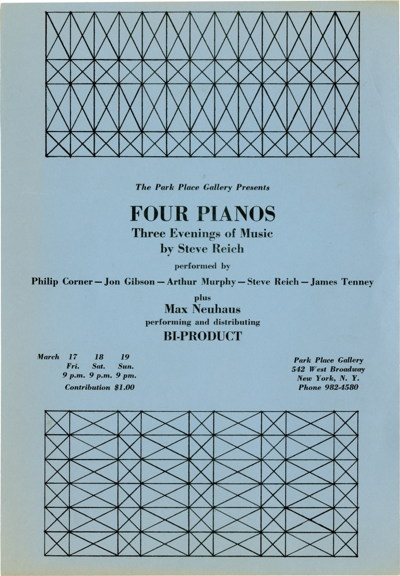 | 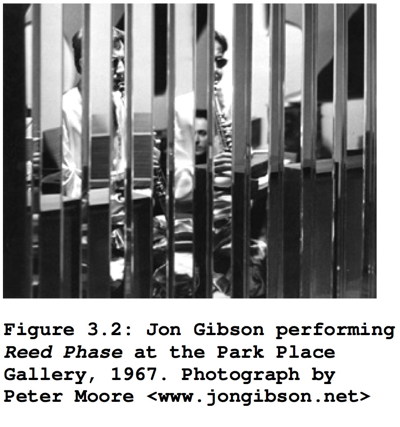 Park Place Gallery, New York, Jon Gibson jouant Reed Phase avec une sculpture de Charles Ross, Prism Wall. On peut voir Steve Reich au travers de la sculpture derrière Jon Gibson. — [Plus d'info] 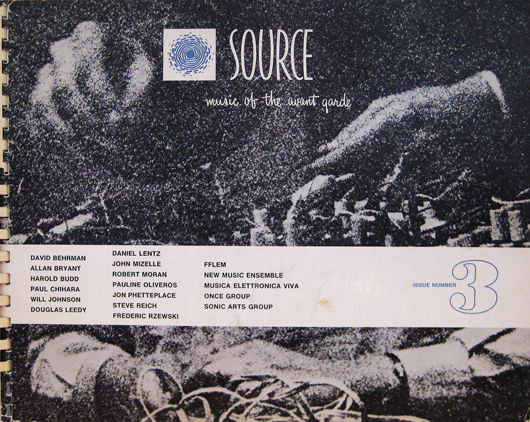 |
Piano Phase (1967)(Edit)
| Durée approximative | — 15-20 minutes | |
| Dates de composition | — 1967 | |
| Création | — 1967 - Madison/Teaneck, N. J., Farleigh Dickinson College - (Art Murphy, Steve Reich, pianos) | |
| Dispositif : | — pour deux pianos ou deux marimbas —— for 2 pianos or marimbas | |
| Éditeur : | Universal Edition |
Tinnitus Piano Duo (Tine Allegaert & Lukas Huisman). Recorded in the Miryhall of the Ghent Music Faculty, 2012. — (Source)
— [Download the full score (pdf)]
| « Late in 1966, I recorded a short repeating melodic pattern played on the piano, made a loop of that pattern, and then tried to play against the loop myself, exactly as if I were a second tape recorder. I found, to my surprise, that while I lacked the perfection of the machine, I could give a fair approximation of it while enjoying a new and extremely satisfying way of playing. » — (Steve Reich) Piano Phase seems to have undergone several revisions, or at least existed in a number of different states before it crystallised into the version in general circulation today. Reich mentions that the pattern he looped and played along to on his tape recorder later became one of the basic units. He describes the collaborative development of the piece as follows : Arthur Murphy and I, both working in our homes, experimented with the performance of this phase shifting process using piano and tape loops. The next step, which happened in late ’66 or early ’67, was that Arthur (who was the first member of my ensemble and a friend from Julliard) and I went out to Fairleigh Dickinson College to do a concert. The night before we went over and did it live, and it was ‘look, Ma, no tape!’ — (Steve Reich) This first performance of the two-piano version was at Fairleigh Dickinson, New Jersey, in January 1967 with Reich and Murphy on pianos. The piece, however, was programmed as Four Pianos in its appearance at the Park Place Gallery two months later and involved four performers on electronic keyboards: Reich, Murphy, Phillip Corner, and James Tenney. Interestingly, in the exhibition catalogue to the 1969 Whitney Museum show ‘Anti-Illusion: Procedures / Materials’, Reich was still describing the piece as ‘a work in progress’. One of the reasons why the score was not completed until after the initial performances was that for Reich and his ensemble the new method of performing by repeating melodic units in different phased relationships meant that it was not necessary to read any notation while they played. In order to perform the piece, Reich suggests, ‘one learns the musical material and puts the score aside’; once the melodic fragments and the basic structure is learnt, the only things contingent upon performance are the total number of repetitions and the speed of the individual transitions. In this sense, Reich advocated an anti-expressive approach to performance and submission to the process as an almost religious act of self- discipline: ‘the pleasure I get from playing is not the pleasure of expressing myself, but of subjugating myself to the music’. Although reminiscent of the ‘machine aesthetic’, Reich saw this as ‘simply controlling your mind and body very carefully as in yoga breathing exercises’ which serve to ‘focus the mind to a fine point’. In a 1970 interview with Michael Nyman, Reich argued that this kind of performance ‘is something we could do with more of, and the “human expressive activity” which is assumed to be innately human is what we could do with less of right now’. Such an attitude can be found in both Reich’s idea that participating in strict musical processes enacts a liberating shift of attention outwards toward ‘it’, as well as his interest in non-Western musical traditions (such as those of Africa and Bali) which, he argues, also ‘have an [aspect of] impersonality to them’. Rather than being a singular process which progresses and concludes ‘on its own terms’, the piece consists of three distinct and clearly ‘composed’ sections. Piano Phase also has the potential to be analysed harmonically, especially as Reich is quite clear that it has an intentional harmonic structure: ‘the piece is divided into three sections...the first is twelve beats in B minor, the second eight beats forming an apparent E dominant chord, and the last is four beats in A (probably major but lacking a stated third degree)’. By far the most comprehensive analytical account of Piano Phase’s long first cycle can be found in Paul Epstein’s 1986 article for the Musical Quarterly (Paul Epstein, ‘Pattern Structure and Process in Steve Reich’s Piano Phase’, The Musical Quarterly, Vol. 72/4 (1986), 495). In it, he provides a neat description of Reich’s phasing process during this section: ‘we have in effect a series of canons, at distances of from 0 to 11 sixteenth notes, alternating with transitions in which the two voices are out of phase with each other’ where (in the middle) a doubling of tempo is perceived. Epstein notes that as a natural outcome of the phasing process ‘the second half of the cycle is a retrograde of the first, with the relationship between the two players reversed’. The remarkable effects produced by the simple phasing process give Piano Phase its momentum, diversity, and character. Epstein argues that ‘the listener is presented with a rich array of possibilities out of which he/she may construct an experience of the piece’. We might therefore argue that this represents a confluence of the ‘impersonal’ (the seeming autonomy of the process) and the ‘personal’ (perceptual discovery). The listener is given freedom, within the apparently restrictive musical structure, to cultivate his or her own perceptual response to, and even path through, the sound world. This, surely, is the strongest riposte to an Adornian reading of Reich’s repetition. Rather than being an ‘objective’ entity forcing our attention and (political) submission to the collective, the original pattern effectively becomes submerged in its own reflections, allowing individuals to reconstruct it as they wish. Instead of being relentless and unchanging, the phase-shifting process actually serves to produce continual variations of the repeated melodic fragment in an essentially non-developmental way. Furthermore, there is even the possibility of overcoming the rigorous nature of the process through repetitive listening: by adopting different strategies as a listener, ranging in levels of engagement, it is possible to gradually seek more interesting or remote possibilities within the unfolding of the music. — (Ross Cole) — [Source (Ross Cole)] | Dans Piano Phase, les deux bandes de It’s Gonna Rain sont remplacées ici par deux pianos, et l’astuce de Reich est de faire se succéder trois cycles de déphasage complets, utilisant des motifs mélodiques de plus en plus courts, contenant respectivement 12, 8 et 4 doubles. Ceci a pour double effet de rendre la longueur du cycle complet de plus en plus courte, et d’accélérer la périodicité du motif, ce qui augmente la tension née de sa répétition. De plus, un processus global gère la longueur des trois motifs, chaque nouveau motif étant diminué de quatre doubles par rapport au précédent : le silence final de l’œuvre peut ainsi être considéré comme un motif de zéro double. Le principe de déphasage progressif et imperceptible n’est pas en soi le moteur fondamental des processus de Steve Reich. Plus importants sont en particulier les moments de superpositions synchrones des doubles croches (ou croches selon la valeur de la pulsation), qui seules engendrent les motifs résultants. À partir de Violin Phase (1967), le processus de déphasage peut être momentanément interrompu lors de ces rencontres rythmiques, ce qui donne lieu à de vastes épisodes musicaux formés uniquement de motifs résultants. Et si seule la superposition synchrone entre doubles croches est déterminante, le déphasage progressif qui fait accélérer une voix jusqu’à avoir une double d’avance, peut devenir superflu. À partir de Clapping music (1971) et Six pianos (1973) le « déphasage » peut se faire de manière abrupte, en prenant directement une double d’avance. Il vaut peut-être alors mieux parler de décalage. Mais plus importante encore est la capacité du déphasage à mener à l’état de saturation rythmique qui conditionne en général la fin d’une partie ou d’une œuvre. Les motifs rythmiques de Reich sont souvent choisis (intuitivement sans doute) pour pouvoir se compléter eux-mêmes après plusieurs décalages. Dans Phase patterns par exemple, quatre décalages sont nécessaires pour mener au remplissage total et uniforme des croches. Comme le processus de saturation n’est pas la source de l’écriture musicale, mais une conséquence du processus de déphasage, il n’est pas forcément linéaire : dans ce cas précis le « degré de saturation » des huit croches observe la progression 4 7 6 5 8. À partir de Six pianos (1973), Steve Reich imagine de créer directement ce processus de saturation sans déphasage ou décalage progressifs. Ce principe a pour caractéristique de rendre plus linéaire l’augmentation du degré de saturation. — (Jérôme Baillet) |
(published in John Cage / Alison Knowles, "Notations", 1969) — [Download pdf]
Piano Phase - first performance(Edit)
Click to enlarge
January 5, 1967 — Concert programme — Fairleigh Dickinson University, Art Gallery — Teaneck, New Jersey
Violin Phase (1967)(Edit)
| Durée approximative | — 11-15 minutes | |
| Dates de composition | — 1967 | |
| Création | — 1967 - New York, The New School - (Paul Zukofsky, violin) | |
| Dispositif : | — pour violon et bande, ou quatre violons —— for violin and tape ; or for four violins | |
| Éditeur : | Universal Edition |
RADIO programme — KPFA-FM, Berkeley, CA ---- (KPFA english version).
Steve Reich, Violin Phase with Paul Zukofsky.
| Ode to Gravity: Survival of the Fiddle - Music by Steve Reich & Michael Sahl June 3, 1970 Two avant-garde works for violin, played by one of the world’s leading artists, Paul Zukofsky. In a Mitzvah for the Dead (for Violin and Tape), Michael Sahl has written a piece in four movements which recalls tonal music as a possibility for usage in not merely collage snippets, but as an important element basic to the conception of the work. In the second work, Violin Phase by Steve Reich, the composer takes samples of sound and subjects them to a sort of magnification that provides the listener with the opportunity to notice elements that would normally be lost. The entire work is generated out of less than sixty seconds of material. It is suggested that the listener suppress any initial desire to turn it of, but to rather increase the volume, sit comfortably, relax, and let go. Notice the combinations formed by the overlapping of the elements and try to use the experience as a liberating, yet impersonal type of ritual. Paul Zukofsky will assist you in this. — [Source] |
London Sinfonietta performing Steve Reich's composition "Violin Phase" at Auditorium Parco della Musica in Roma, Italy, May 2005. . — (Source)
— [Download the full score (pdf)]
| In October 1967 Reich completed Violin Phase, a piece which he suggests ‘was basically an expansion and refinement of Piano Phase’ in two ways. Firstly, rather than two voices, there were now four (although Piano Phase also had four at one stage in its evolution, and Reed Phase had three). Secondly, it was in this piece that the possibility of creating new melodies out of the total phasing aggregate produced by the interlocking voices was explored. Reich asserted that these various emergent patterns ‘can be understood as psychoacoustic by-products of the repetition and phase-shifting’ and, in Violin Phase, are ‘pointed out’ by the live violin doubling certain notes within the aggregate. There is some controversy surrounding the early performances of the piece: D. J. Hoek, for example, has the premiere down as April 1969 at the New School, New York. Carman Moore, however, has evidence to suggest otherwise: whilst reviewing this performance in the Village Voice, he wrote that ‘Reich’s Violin Phase was not new to me. I heard it some time ago at the School of Visual Arts, but liked it much better this time under Zukofsky’s reading’. He states that the artist Robert Rauschenberg was ‘responsible for mounting a series of performances at New York’s School of Visual Arts late in 1967, which included the premiere of Violin Phase (a year before Paul Zukofsky’s performance)’. This was the November 1967 concert at which My Name Is: Ensemble Portrait was also premiered. Zukofsky was the first to record Violin Phase, his version being released on the 1968 Columbia Masterworks LP, Steve Reich: Live / Electronic Music (MS 7265), as the A-side to It’s Gonna Rain. Zukofsky’s recorded version lasts just over twenty-three minutes, whereas the version he played at the New School in 1969 lasted ‘a full half hour’, according to Donal Henahan Some members of the audience at a Berkeley performance in 1970 – with Zukofsky as the multi-tracked soloist for a half-hour performance – reacted badly to the piece, according to Los Angeles Times critic John Rockwell. He described the piece favourably as ‘a shifting tapestry of overlapping sounds in which...different aspects of the original tune drift to the surface of one’s awareness’. For Edward Strickland, Violin Phase represents ‘Reich’s first step away from the reductive simplicity of his early minimalist style’, due to its inclusion of indeterminate resulting patterns and its lack of cyclical structure ending in unison. What is perhaps most remarkable about Violin Phase is its structure, and the way performance latitude is built into it. In a move which represents both a departure from Piano Phase and an echo of earlier works such as Melodica, the phasing cycle is not returned to unison. Rather, two separate phasing processes occur which serve to ‘lock’ a particular relationship in for the rest of the piece and which are then used as the basis for a kind of structured improvisation. Reich therefore uses these phasing processes not as ends in themselves, but as means to the production of modal ostinati which are then used as raw material for the creation of new melodies. It is possible to see that both Piano Phase and Violin Phase, even at their most seemingly mechanical, are very carefully composed and thereby contain features which are effectively ‘secrets of structure’, privy only to the composer and not overtly apparent. Within the seemingly restrictive confines of their processes, these pieces actually contain considerable room for subjective manoeuvre, including contingency of perceptual response (due to deliberate ambiguity of metre and tonality), the introduction of human fallibility in performance, and the freedom to choose resulting patterns from an aggregate. Such factors combine to undermine any sense of ‘objective’ or ‘mechanical’ coercion in the music. — (Ross Cole) | Violin Phase est une des premières œuvres du compositeur américain Steve Reich écrite en octobre 1967 dans le style de la musique de déphasage pour quatre violons ou un violon et bande magnétique. Composé en octobre 1967, Violin Phase fait suite à Piano Phase qui fut sa première composition répétitive pour instrument utilisant le phasage/déphasage. Steve Reich considère que Violin Phase est "une expansion et un raffinement de Piano Phase". Toutefois Violin Phase représente une évolution par rapport à la pièce fondatrice de la série puisqu'elle rend plus perceptible pour l'auditeur les « motifs résultants » générés par le principe de phasing des quatre voix, bien qu'ils soient non écrits sur la partition. La pièce est composée pour un violon solo et trois violons enregistrés sur bande magnétique mais doit être préférablement jouée par quatre violons en direct afin de renforcer la densité de la texture et du contrepoint. Violin Phase est écrit dans la tonalité de fa# mineur. L'œuvre commence par la répétition d'un court thème au violon, à laquelle s'ajoute le même motif décalé d'une note en avant, joué soit par un second puis un troisième violon, soit par une bande magnétique pré-enregistrée. Reich développe et enrichi ses compositions en produisant de nouvelles chimères sonores, « sous-produits psycho-acoustiques de la répétition », dépendants de l'attention de l'auditeur et issues de son principe de phasage/déphasage appliqué à quatre voix. La perception de ces motifs résultants est cependant différente d'un auditeur à l'autre selon son attention sur une ligne mélodique dédiée ou sa focalisation acoustique sur un plan sonore donné à la manière des perceptions visuelles des jeux d'illusions optiques. L'exécution de l'œuvre dure environ 15 minutes. - [Source (wikipedia)] |
Études / Studies
Documentary / Documentaire (1987)(Edit)
This film portrait of minimalist composer Steve Reich begins with an introduction to the man himself, revealing something of his personality and the origins of his musical ideas. Reich talks with candour and humour and about his life and musical development. The second and third parts deal with how the music became accessible to a wider audience and its relationship to the contemporary music scene. The film covers Reich’s work over the last twenty years from the early tape pieces to recent orchestral work, with extracts from concerts filmed in England and New York. Music extracts include: Pendulum Music (1968); Four Organs (1970); Drumming Parts! & 3 (1971); Clapping Music (1972); Vermont Counterpoint (1982); Sextet (1985); New York Counterpoint (1985).
Dur : 56mn
Year : 1987
Director : Margaret Williams
Contributors : Michael Tilson Thomas; Ransom Wilson; Richard Stoltzman; Steve Reich.
TV Special Alternate Title: Great Performances (UK) (04/10/87)
Source : http://www.ubu.com/film/reich_new.html
Lire la suite - sixième partie / Continue reading - part6 - Pendulum Music (1968)
